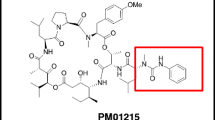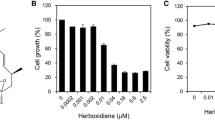Abstract
Angiogenesis is a crucial process in inflammatory reactions as well as in tumor implantation and growth. Tumors with high rates of invasion and recurrence such as gliomas, are specially dependent on neovascularization. This suggests that inhibition of angiogenesis might reduce the growth of these tumors. Thalidomide has been previously shown to inhibit angiogenesis induced by basic fibroblast growth factor in vivo, using the rabbit corneal micropocket assay. Therefore, the effect of thalidomide and a thalidomide analogue (cc-1069) on the proliferation in vitro of endothelial and glioma cells was tested. We observed a decrease in endothelial cell proliferation in cultures treated with thalidomide or the thalidomide analogue cc-1069. The analogue inhibited endothelial cell proliferation more efficiently than thalidomide. The inhibition occurred in association with a marked decrease in the activity of the nuclear factor SP1 and a moderate inhibition of NF-κB activation in nuclear extracts of endothelial cells. The drugs did not impair cell viability. There was no effect of thalidomide or the thalidomide analogue on the proliferation of the glioma cell line (U251) in vitro.
Similar content being viewed by others
References
Kleihues P, Soylemezoglu F, Schauble B, Scheithauer BW, Burger PC: Histopathology, classification, and grading of gliomas. Glia 15: 211–221, 1995
Libermann TA, Friesel R, Jaye M, Lyall RM, Westermark B, Drohan W, Schmidt A, Maciag T, Schlessinger J: An angiogenic growth factor is expressed in human glioma cells. EMBO J 6: 1627–1632, 1987
Zagzag, D: Angiogenic growth factors in neural embryogenesis and neoplasia. Am J Pathol 146: 293–309, 1995
Zagzag D, Miller DC, Sato Y, Rifkin DB, Burstein DE: Immunohistochemical localization of basic fibroblast growth factor in astrocytomas. Cancer Res 50: 7393–7398, 1990
Folkman J: Anti-angiogenesis: new concepts for therapy of solid tumors. Ann Surg 175: 409–416, 1972
Sampaio EP, Sarno EN, Galilly R, Cohn ZA, Kaplan G: Thalidomide selectively inhibits tumor necrosis factor α production by stimulated human monocytes. J Exp Med 175: 699–703, 1991
Moreira AL, Sampaio EP, Zmuidzinas A, Frindt P, Smith KA, Kaplan G: Thalidomide exerts its inhibition action on tumor necrosis factor α by enhancing mRNA degradation. J Exp Med 177: 1675–1680, 1993
Tramontana JM, Utaipat U, Molloy A, Akarasewi P, Burroughs M, Makonkawkeyoon S, Johnson B, Klausner JD, Rom W, Kaplan G: Thalidomide treatment reduces tumor necrosis factor α production and enhances weight gain in patients with pulmonary tuberculosis Mol Med 1: 384–397, 1995
Moreira AL, Tsenova-Berkova L, Wang J, Laochumroonvorapong P, Freeman S, Freedman VH, Kaplan G: Effect of cytokine modulation by thalidomide on the granulomatous response in murine tuberculosis. Tuberc Lung Dis 78: 47–55, 1997
Sheskin J: Thalidomide in the treatment of lepra reactions. Clin Pharmacol Therap 6: 303–306, 1965
Gardner-Medwin JMM, Smith NJ, Powell RJ: Clinical experience with thalidomide in the management of severe oral and genital ulcerations in conditions such as Behcet's disease: use of neurophysiological studies to detect thalidomide neuropathy. Ann Rheum Dis 53: 828–832, 1994
Paterson DL, Georghiou PR, Allworth AM, Kemp RJ: Thalidomide as treatment of refractory aphtous ulceration related to human immunodeficiency virus infection. Clin Inf Dis 20: 250–254, 1995
Vogelsang GB, Taylor S, Gordon G, Hess AD: Thalidomide, a potent agent for the treatment of graft-versus-host disease. Transplant Proc 4: 904–906, 1986
D'Amato RJ, Loughnan MS, Flynn E, Folkman J: Thalidomide is an inhibitor of angiogenesis. Proc Natl Acad Sci USA 91: 4082–4085, 1994
Fine HA: Novel biologic therapies for malignant gliomas. Antiangiogenesis, immunotherapy, and gene therapy. Neur Clin 13: 827–846, 1995
Corral LG, Muller GW, Moreira AL, ChenY, Wu M, Stirling D, Kaplan G: Selection of novel analogues of thalidomide with enhanced tumor necrosis factor inhibitory activity. Mol Med 2: 506–515, 1996
Leibovich SP, Polverini PJ, Shepard HM, Wiseman DM, Shively V, Nuseir N: Macrophage-induced angiogenesis is mediated by tumor necrosis factor α. Nature 329: 630–632, 1987
Fajardo LF, Kwan HH, Kowalski J, Prionas SD, Allison AC: Dual role of tumor necrosis factor α in angiogenesis. Am J Pathol 40: 539–544, 1992
Yoshida S, Ono M, Shono T, Izumi H, Ishibashi T, Suzuki H, Kuwano M: Involvement of interleukin-8, vascular endothelial growth factor, and basic fibroblast growth factor in tumor necrosis alpha-dependent angiogenesis. Mol Cell Biol 17: 4015–4023, 1997
Shono T, Ono M, Izumi H, Jimi S, Matsushima K, Okamoto T, Kohno K, Kuwano M: Involvement of transcription factor NF-κB in tubular morphogenesis of human microvascular endothelial cells by oxidative stress. TMol Cell Biol 16: 4231–4239, 1996
Neish AS, Khachigian LM, Park A, Baichwal VR, Collins T: SP1 is a component of the cytokine-inducible enhancer in the promoter of vascular cell adhesion molecule-1. J Biol Chem 270: 28903–28909, 1995
Friedlander DR, Zagzag D, Schiff B, Cohen H, Allen JC, Kelly PJ, Grumet M: Migration of brain tumor cells on extracellular matrix proteins in vitro correlates with tumor type and grade and involves α v and β 1 integrins. Cancer Res 56: 1939–1947, 1996
Kondo S, Asano M, Suzuki H: Significance of vascular endothelial growth factor/vascular permeability factor for solid tumor growth, and its inhibition by the antibody. Biochem Biophys Res Commun 194: 1234–1241, 1993
Millauer B, Wizigmann-Voos S, Schnurch H, Martinez R, Moller NP, Risau W, Ullrich A: High affinity VEGF binding and developmental expression suggest Flk-1 as a major regulator of vasculogenesis and angiogenesis. Cell 72: 835–846, 1993
Tischer B, Mitchell R, Hartman T, SilvaM, Gospodarowicz D, Fiddes JC, Abraham JA: The human gene for vascular endothelial growth factor. J Biol Chem 266: 11947–11954, 1991
Patterson C, Perella MA, Hsieh CM, Yoshizumi M, Lee ME, Haber B: Cloning and functional analysis of the promoter for KDR/flk-1, a receptor for vascular endothelial growth factor. J Biol Chem 270: 23111–23118, 1995
Moreira AL, Corral LG, Ye W, Johnson B, Stirling D, Muller GW, Freedman VH, Kaplan G: Thalidomide and thalidomide analogues reduce HIV type 1 replication in human macrophages in vitro. AIDS Res Human Retrov 13: 857–863, 1997
Patterson C, Wu Y, Lee ME, DeVault JD, Runge MS, Haber E: Nuclear protein interactions with the human KDR/flk-1 promoter in vivo. Regulation of SP1 binding is associated with cell type-specific expression. J Biol Chem 272: 8410–8416, 1997
Author information
Authors and Affiliations
Rights and permissions
About this article
Cite this article
Moreira, A.L., Friedlander, D.R., Shif, B. et al. Thalidomide and a Thalidomide Analogue Inhibit Endothelial Cell Proliferation in vitro. J Neurooncol 43, 109–114 (1999). https://doi.org/10.1023/A:1006202700039
Issue Date:
DOI: https://doi.org/10.1023/A:1006202700039




